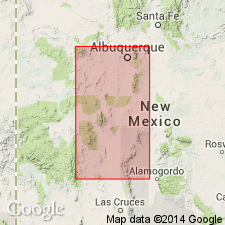
- Usage in publication:
-
- Magdalena group*
- Modifications:
-
- Original reference
- Dominant lithology:
-
- Limestone
- Shale
- Sandstone
- AAPG geologic province:
-
- Estancia basin
- Orogrande basin
- San Juan basin
Summary:
Pg. 807-816. Magdalena group. Divided into (descending) Madera limestone (300 to 700 feet of dark-blue limestone) and Sandia formation (500 to 700 feet of alternating beds of blue and black clay shale, compact earthy limestone and conglomerate, vitreous sandstone or quartzite; shale and limestone predominate). In Magdalena Mountains overlies Kelly limestone (Mississippian). [Age is Early Pennsylvanian.]
[Named from development in Magdalena Mountains, Soccorro Co., southwestern NM.]
Source: US geologic names lexicon (USGS Bull. 896, p. 1266).
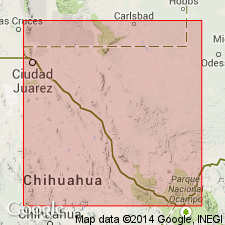
- Usage in publication:
-
- Magdalena limestone*
- Modifications:
-
- Areal extent
- AAPG geologic province:
-
- Orogrande basin
- Permian basin
Summary:
Pg. 697-798. Extended Magdalena limestone into Texas (where he identified the formation in Hueco and Franklin Mountains and in a small area in Sierra Diablo) and restricted Hueco limestone to beds of Permian(?) age, unconformably overlying the Magdalena.
Source: US geologic names lexicon (USGS Bull. 896, p. 1266).
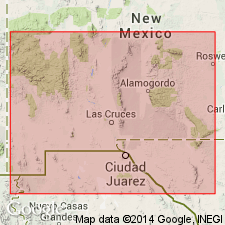
- Usage in publication:
-
- Magdalena formation
- Modifications:
-
- Revised
- AAPG geologic province:
-
- Orogrande basin
Summary:
Pg. 157-172. Magdalena [group]; Magdalena limestone. At Silver City, New Mexico, Magdalena formation [group] is divided into two formations, Oswaldo below, about 400 feet thick, and Syrena above, about 400 feet thick; unconformably overlies Lake Valley limestone. In northern end of Oscura Mountains, the Magdalena rests on Precambrian granite, and is about 1,000 feet thick. Increases northward to Taos region to about 3,000 feet. Southward from Oscura Mountains, in regions of San Andres and Organ Mountains, has thickness of about 3,000 feet and is composed almost entirely of limestone. In San Andres and northern end of Organ Mountains, overlies Lake Valley limestone; in southern end of Organ Mountains, apparently overlies Fusselman limestone. In Sacramento Mountains, overlies Lake Valley limestone. In Hueco and Franklin Mountains disconformable above the Helms. In Franklin Mountains, formation consists of (ascending) La Tuna, Berino, and Bishops Cap members. Underlies Abo sandstone. [Age is Pennsylvanian and Permian.]
Source: US geologic names lexicon (USGS Bull. 1200, p. 2323-2325).
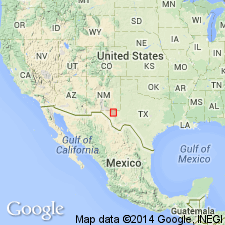
- Usage in publication:
-
- Magdalena group*
- Modifications:
-
- Age modified
- AAPG geologic province:
-
- Permian basin
Summary:
Pg. 674-677, 687. Magdalena group. Northwest of Delaware basin, later Paleozoic rocks are divided into Magdalena and Manzano groups. Magdalena is marine deposit, containing many limestone beds, and is generally classed as Pennsylvanian. Basal formation of Manzano is Abo sandstone. In previous reports, the Abo was considered approximately equivalent to Wolfcamp series, and supposed unconformity at its base was supposed to be same as that at base of Wolfcamp. It is herein suggested that Abo is mostly or wholly post-Wolfcamp and that equivalent of Wolfcamp series lies in upper part of Magdalena group as at present defined and mapped. In Sacramento, San Andres, and other mountains of New Mexico, the usual limestones and other marine sediments of Magdalena group pass upward into several hundred feet of interbedded limestones, red and gray shales, sandstones, and arkosic conglomerates. The limestones contain fusulinids and other invertebrates, and the shales contain fossil plants. This unit forms upper part of Magdalena group and no doubt will be classed as separate formation when further work is done. Future work may indicate desirability of shifting unit from Magdalena to Manzano group. Evidence suggests that upper unit of Magdalena group, as now defined, is traceable southward into Hueco limestone of Wolfcamp series.
Source: US geologic names lexicon (USGS Bull. 1200, p. 2323-2325).
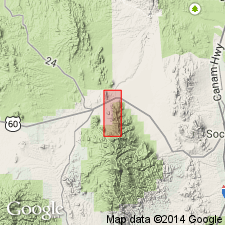
- Usage in publication:
-
- Magdalena group*
- Modifications:
-
- Areal extent
- AAPG geologic province:
-
- Estancia basin
- Orogrande basin
- San Juan basin
Summary:
Pg. 16, 19-20 [Discussion of Carboniferous System rocks by V.T. Stringfield, A.H. Koschmann, and G.F. Loughlin], pls. 2, 8, 31.
Magdalena group. In Magdalena mining district, New Mexico, comprises (ascending) Sandia formation and Madera limestone. Thickness about 850 feet. Overlies Kelly limestone; underlies Abo limestone. [Age is Pennsylvanian.]
Source: US geologic names lexicon (USGS Bull. 1200, p. 2323-2325).
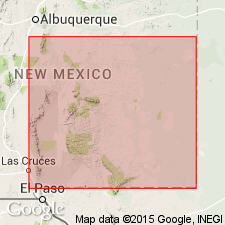
- Usage in publication:
-
- Magdalena group
- Modifications:
-
- Not used
- AAPG geologic province:
-
- Estancia basin
- Orogrande basin
- Palo Duro basin
- Permian basin
Summary:
Pg. 21. Magdalena group. Thompson (1942) did not use term Magdalena in his Pennsylvanian classification. King (1942) referred to Hueco equivalent in mountains of southern New Mexico as "upper part of Magdalena group." He suggested that "future work would no doubt indicate desirability of shifting the unit to the Manzano group" (Abo, Yeso, and San Andres). Such change has not been made and name Magdalena has become more entrenched in recent geologic literature of the U.S. Geological Survey, in which the Hueco is continued to be classed as Magdalena. Names Pennsylvanian and Hueco are fully adequate for designation of these strata. It is herein recommended that term Magdalena be permanently abandoned.
Source: US geologic names lexicon (USGS Bull. 1200, p. 2323-2325).
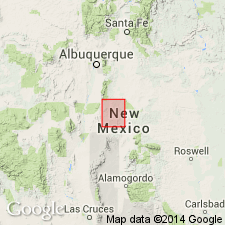
- Usage in publication:
-
- Magdalena group
- Modifications:
-
- Not used
- AAPG geologic province:
-
- Estancia basin
- Orogrande basin
- San Juan basin
Summary:
Pg. 17. On grounds of redundancy in stratigraphic nomenclature, New Mexico Bureau of Mines and Mineral Resources no longer uses term Magdalena.
Source: US geologic names lexicon (USGS Bull. 1200, p. 2323-2325).
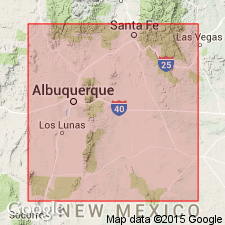
- Usage in publication:
-
- Magdalena group*
- Modifications:
-
- Areal extent
Summary:
Pg. 220-236. Magdalena group. Term is applied to all marine beds between Mississippian below and Permian nonmarine Abo above. This usage is in rather close agreement with earlier definitions of the term. Upper limit of Magdalena group, as term is used here, is not a time line but represents limit of marine sedimentation in area.
Source: US geologic names lexicon (USGS Bull. 1200, p. 2324-2325).
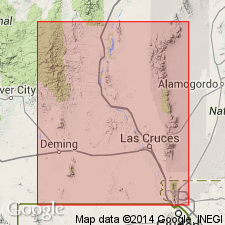
- Usage in publication:
-
- Magdalena group
- Modifications:
-
- Revised
- AAPG geologic province:
-
- Orogrande basin
Summary:
p. 88-97. In Caballo Mountains, Magdalena group is divided into (ascending) Red House, Nakaye, and Bar B formations (all new). Thickness 1,120 to 1,700 feet. Overlies Cutter formation, Upham dolomite, Cable Canyon sandstone, Percha formation, or Nunn member of Lake Valley limestone. Underlies Abo formation. Thompson's (1942) Pennsylvanian terminology rejected in this report.
Source: US geologic names lexicon (USGS Bull. 1200, p. 2323-2325).
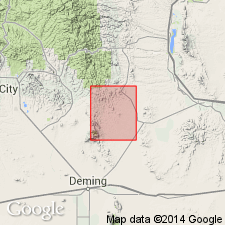
- Usage in publication:
-
- Magdalena group*
- Modifications:
-
- Areal extent
- AAPG geologic province:
-
- Basin-and-Range province
Summary:
Pg. 21-23, 34 (fig. 3). In Cooks Range, Lake Valley quadrangle, a section of 182 feet of Pennsylvanian sediments is referred to Magdalena group. Unconformably overlies Lake Valley formation; unconformably underlies Lobo formation.
Source: US geologic names lexicon (USGS Bull. 1200, p. 2323-2325).
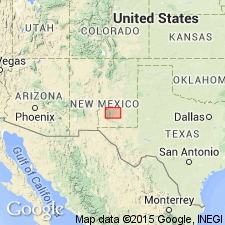
- Usage in publication:
-
- Magdalena group
- Modifications:
-
- Revised
- AAPG geologic province:
-
- Orogrande basin
Summary:
Pg. 93. Composite columnar section, Sacramento Mountains, southeastern New Mexico, shows Magdalena group comprises (ascending) Gobbler (new), Beeman (new), Holder (new), and Bursum formations. Bursum is Permian. Overlies Helms formation; underlies Abo formation.
Source: US geologic names lexicon (USGS Bull. 1200, p. 2323-2325).
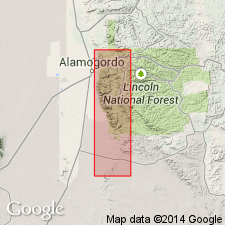
- Usage in publication:
-
- Magdalena group
- Modifications:
-
- Not used
Summary:
Term Magdalena formation or group has been used to encompass strata as old as Mississippian and as young as Permian. Is shown on the geologic map as including the Gobbler (and its Bug Scuffle limestone member), Beeman, and Holder formations of this report. The term Magdalena is thought by the author to be so broad a term that it serves little purpose; term not used in text figures.
Source: GNU records (USGS DDS-6; Denver GNULEX).
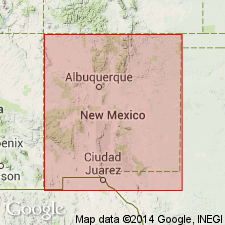
- Usage in publication:
-
- Magdalena Group
- Modifications:
-
- Not used
Summary:
Sandia Formation could not be consistently delineated in the southern part of the report area--upper Pecos Valley area, including the Dalton Bluff exposure 6 mi north of Pecos, southern edge of Sangre de Cristo Mountains, San Miguel Co, NM in Palo Duro basin--consequently, name "Sandia" not used in this report. Pennsylvanian rocks in southernmost Sangre de Cristos here divided into (both new): 1) La Pasada Formation, 973 ft thick at Dalton Bluff, San Miguel Co, NM, Palo Duro basin, and equal there to Sandia Formation plus the lower gray limestone member of Madera Limestone (as used in this area by Brill, 1952); and 2) Alamitos Formation (about 1,275 ft thick in Alamitos and Pecos Valley areas, San Miguel Co, and equal to the upper arkosic limestone member of Madera Limestone (of Brill). Stratigraphic relations of these two new formations to the "Madera Limestone" of Sandia Mountains further to southwest is unknown--therefore, term "Madera" not used in report area. "Magdalena Group" not used either, because it is essentially synonymous with systemic term "Pennsylvanian". La Pasada Formation's northern equivalent is Flechado Formation (new); Flechado extends north of Jicarilla area, Rio Arriba Co, to Taos area, San Luis basin. Measured sections, geologic map, correlation chart.
Source: GNU records (USGS DDS-6; Denver GNULEX).
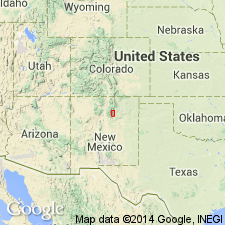
- Usage in publication:
-
- Magdalena Group*
- Modifications:
-
- Areal extent
- AAPG geologic province:
-
- Las Vegas-Raton basin
Summary:
Use of Magdalena Group discontinued in southeastern Sangre de Cristo Mountains in Las Vegas-Raton basin, where name Magdalena replaced by Arroyo Penasco Group (base), Sandia Formation, and Madera Group. In northern part of mountains in Las Vegas-Raton basin where the sequence is of marine and nonmarine rocks and has not been divided, name Magdalena can be used in restricted sense for rocks between the Pennsylvanian sequence between Arroyo Penasco Group beneath and Sangre de Cristo Formation above.
Source: GNU records (USGS DDS-6; Denver GNULEX).
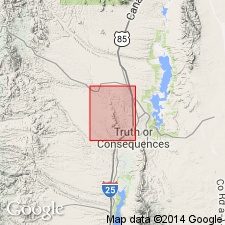
- Usage in publication:
-
- Magdalena Group*
- Modifications:
-
- Overview
- AAPG geologic province:
-
- Orogrande basin
Summary:
Magdalena Group in the Mud Springs Mountains of Sierra Co, NM in the Orogrande basin, divided into the (ascending): Red House, Nakaye, and Bar B Formations of Pennsylvanian age; and Bursum Formation of Early Permian age. The group unconformably overlies Upper Devonian Percha Shale in southern half of mountains and Upper Ordovician Cutter Dolomite of Montoya Group in northern half of mountains. The group underlies Lower Permian Abo Formation.
Source: GNU records (USGS DDS-6; Denver GNULEX).
For more information, please contact Nancy Stamm, Geologic Names Committee Secretary.
Asterisk (*) indicates published by U.S. Geological Survey authors.
"No current usage" (†) implies that a name has been abandoned or has fallen into disuse. Former usage and, if known, replacement name given in parentheses ( ).
Slash (/) indicates name conflicts with nomenclatural guidelines (CSN, 1933; ACSN, 1961, 1970; NACSN, 1983, 2005, 2021). May be explained within brackets ([ ]).

